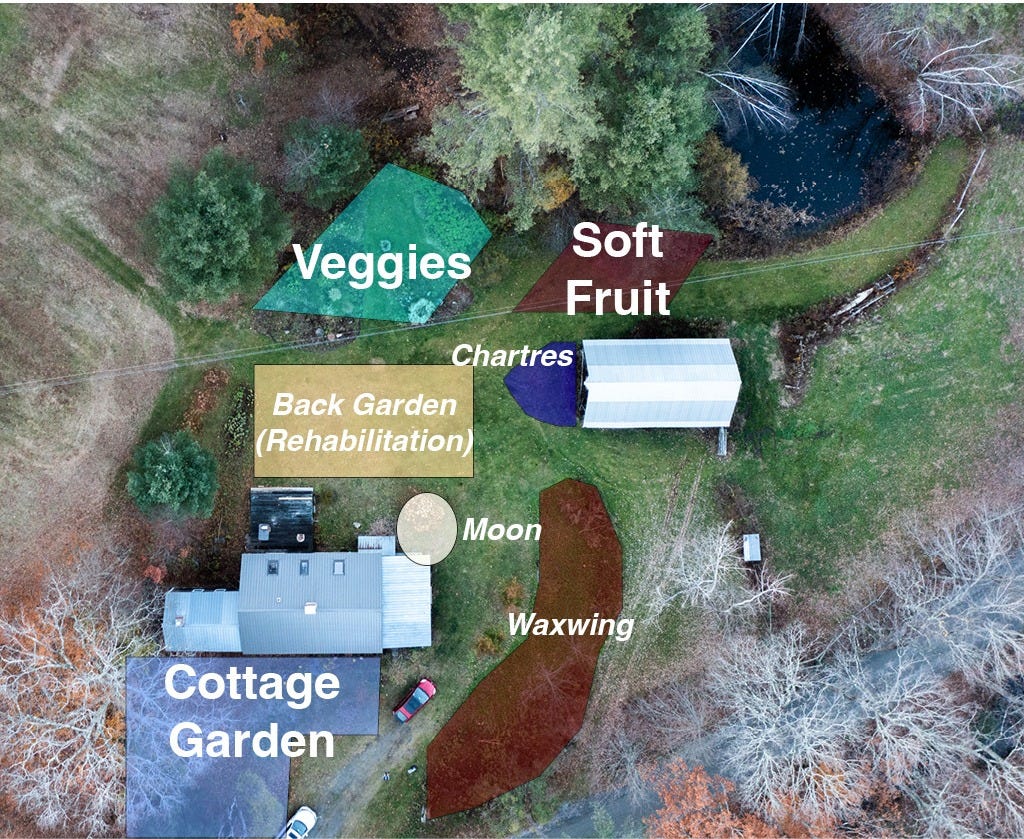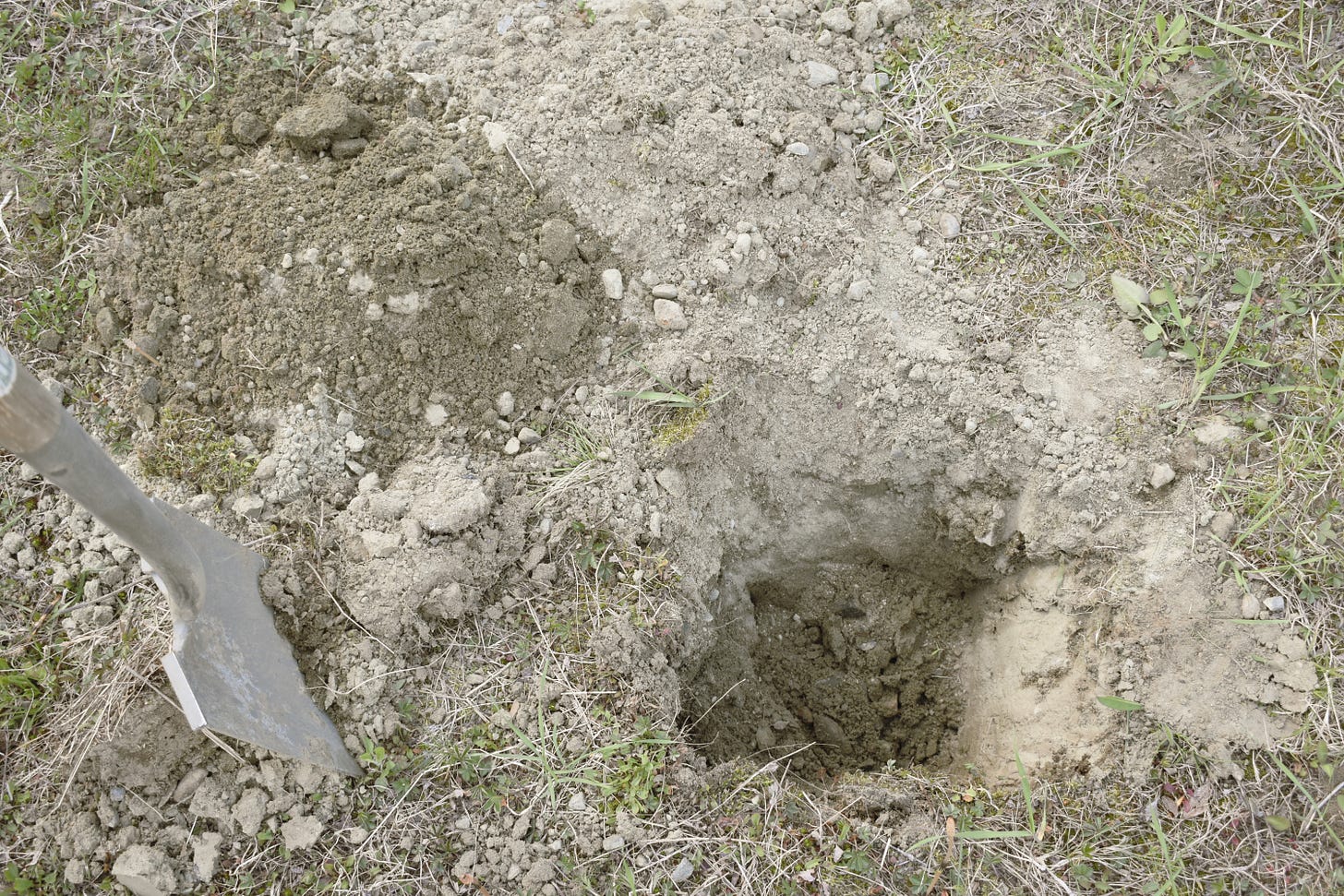How Fast Can You Build Soil Organic Matter?
I take on the world speed record in my backyard.
Soil organic matter is the simplest and most powerful metric of healthy soil. In general: low organic matter = bad; high organic matter = good.
Soil organic matter (SOM) is the carbon-containing component of soil, and is basically decomposed life. The rest of soil is sand, silt, clay—essentially very small rocks. Organic matter is “the constitution of the soil,” in the words of William Albrecht.
Benefits of organic matter include:
water retention (each percentage point increase in SOM can increase a soil’s water-holding capacity by 25,000 gallons)
storage of critical nutrients and releases them to plants, preventing leaching (boosts cation exchange capacity (CEC) by up to 70%)
improved soil structure for better aeration, drainage, and root growth
food and housing for microbes
stably sequestered carbon
Typical soils may range from 1% to 6% organic matter. Ideally, for a garden, you’d want levels upwards of 5%, approaching 10% or more SOM. Pure compost is about 50% organic matter. In natural ecosystems, soil organic matter is built at about a tenth of a percent to a hundredth of a percent per year. So in ordinary times, it could take a century or more to add one percentage point of organic matter to the soil. But these are not ordinary times.
Soil organic matter across the world has been depleted by centuries of extractive agricultural practices. “Over the last 150 years, many of the world’s prime agricultural soils have lost between 30% and 75% of their carbon, adding billions of tonnes of CO2 to the atmosphere.”1 Many farmlands in the USA are currently sitting around 2% organic matter—abysmal levels. We desperately need to build SOM fast—much faster than the 1% per century that Nature pulls off.
My backyard
My backyard has a particularly poor patch of soil that is 0.2% organic matter: it’s basically pure sand. Even the weeds struggle to grow there.2
But it’s in a premium location: in view of the kitchen windows, right outside the back door, between the house and the vegetable garden. It would make an excellent place for a garden, whether ornamentals or more vegetables. But nothing will grow in 0.2% soil organic matter, so I’ll have to improve it. But I don’t want to wait two centuries for Nature to get it to 2.2%.
Because I’m a competitive fellow, I got to wondering how fast one can build organic matter in a single year. My boss John Kempf claims that regenerative practices can increase soil organic matter while a crop is growing by 0.25% to 0.5% points per year. I met a Texan on LinkedIn who increased SOM about 2.5% points in a single year using cover crops.
After lots of research, and inspiration from John Kempf and Christine Jones, I’ve come up with a plan to try for the organic matter speed record.3

The Theory
Fundamentally, organic matter is carbon that has been transferred from the atmosphere to the soil. So my goal in this experiment is to transfer as much carbon as possible from the atmosphere into the soil.
The most efficient carbon capture technology ever developed is photosynthesis.
The most effective way to get photosynthetic carbon stabilized in the soil is through plant root exudates.4
So the way to maximize SOM formation is by optimizing both photosynthesis and root exudates.
Optimizing Photosynthesis
Foliar Nutrition
The thesis behind the company where I work is essentially “plants photosynthesize at only 20% of their inherent genetic capacity. Proper nutrition can increase the amount a plant photosynthesizes by as much as 3-4x.”
Foliar nutritional sprays are the quickest and easiest way to increase a plant’s photosynthetic efficiency. So my experiment will rely on foliars.
C4 Plants
The majority of plants use a mechanism known as C3 photosynthesis. But some, like corn, sugarcane, and sorghum, have evolved a specialized photosynthetic pathway called C4, which basically increases photosynthetic efficiency by reducing evapotranspiration. Some common C4 plants include corn and sorghum. Using C4 plants as cover crops can maximize carbon capture.
Optimizing Exudates
Some plants store excess sugars in their own root systems while others store them in the soil surrounding their roots—essentially the difference between keeping your savings under the mattress vs. in a bank. This second group of plants is basically loaning their sugars to the soil microbiome with the understanding that they’ll get paid back later in the season when the creation of fruits and seeds creates a need for lots of sugar in the plant. But if you terminate the plants before they start withdrawing from their soil checking accounts, then all that sugar—and its carbon—stays in the soil.
The Plan
Here’s my plan for this year:
Add mineral soil amendments like gypsum and boron at the beginning of the season (I’d normally add biochar, but for the sake of this experiment, I want all carbon to come from growing plants)
Plant a succession of C4 cover crops (primarily sorghum-sudangrass and corn).
Mow them just before they start their reproductive stage (when they divert sugars away from exudates)
Add AEA’s soil primer at each planting to supercharge soil biology5
Apply biweekly broad-spectrum nutritional foliars to optimize sugar production through photosynthesis
Plant a cold-season cover crop mix at the end of the season to cover the ground and keep feeding biology through the winter.
In one year, I’ll send soil samples to a lab to measure SOM, and I’ll post the results.
I expect this experiment to add at least 2% SOM in a year. That would be 200 times faster than organic matter is built in natural ecosystems.
The entire cost of this program for 1000 sq feet is about $35 (not including labor).6 Adding a comparable amount of SOM through purchased compost would cost more than 10 times that.7
The beauty of this technique is its scalability: with the right equipment, it could be implemented on any scale: from an urban yard to a million acres.
My planned program costs $1000 per acre per year (without labor). You could easily cut the cost in half by only doing 2 soil primer applications (spring and fall) and 3 foliars (one per cover crop), with more savings possible through volume discounts.
While that seems like a pretty penny over a large scale (try convincing a farmer to drop a chill million doing this on 1,000 acres—while not producing a crop for a year), it would be interesting to compare it to the economic value of a percentage point of organic matter. I’d like to explore that topic in depth in a future post, but some quick back-of-the-envelope math shows that it could actually be a very good investment.8
Inspiration, not Imitation
Let’s conclude with an important philosophical point about regenerative agriculture.
Some would say that the path to regeneration lies in imitating nature: humans just need to get out of the way and let nature do her thing. This so-called “nature-based solutionism” formed the meat of a scathing rebuke of regenerative agriculture published recently in The New Republic.
My problem with that idea is that nature’s systems were not designed to function at the speed or scale of the anthropocene. Left alone, Nature takes a century to build 1% SOM. Humans can burn through that in a few years.
I propose that nature should be a source of inspiration rather than imitation. We should harness natural systems as tools, because they are incredibly functional, but we must super-charge them to meet the needs of this time. That’s how we’ll get ourselves out of our present pickle.
This philosophy is embedded in the method of regeneration I’m trying here: every step harnesses natural processes, but it stacks and hacks them in an attempt to produce a result exponentially more powerful than would happen if they were left alone.
Want to know how it all turns out? I’ll post the results in a year. Subscribe to get updates.
Don’t forget about the Johnny’s Garden Leaderboard and the sweet prizes that await you for referring new subscribers!
3 referrals = shoutout on the blog
10 referrals = Zoom garden consult
25 referrals = Johnny’s Garden t-shirt!
From “Light Farming” by Dr. Christine Jones. https://amazingcarbon.com/JONES-LightFarmingFINAL(2018).pdf
Full soil test results here. The soil on my eroded Vermont hilltop are generally poor, but this patch is an outlier. I’d like to know its history to learn how it got this way. Was there a building foundation there at one point?
Here I should note: I have no idea what the world record for 1-year SOM creation is. Does anyone know?
“It comes as a surprise to many to learn that over 95% of life on land resides in soil—and that most of the energy for this amazing world beneath our feet is derived from plant carbon. Exudates from living roots are the most energy-rich of these carbon sources. . . . For a range of physical, biological and chemical reasons, the conversion of carbon inputs into stable carbon is higher for root-derived materials than for above-ground biomass. . . . Overall, the stabilisation of root-derived carbon was five times higher than that from above-ground biomass.” [emphasis added]
Jones. “Light Farming.” https://amazingcarbon.com/JONES-LightFarmingFINAL(2018).pdf
I’m an employee of Advancing Eco Agriculture, so I’ll be relying on their products. I get a sweet employee discount, but all costs here are calculated at full retail price.
A 1” layer of compost would add about 3.3 percentage points of organic matter to the topsoil. Covering 1000 sqft in 1” would require 3.2 cubic yards of compost, which costs $400 + shipping, (at going wholesale rates from the Vermont Compost Company)—well over 10x as expensive as my plan.
That level of OM increase also only considers the top 6 inches of topsoil—C4 cover crops can build organic matter at depths of up to 40”, a potentially massive difference in total carbon on a per-acre basis.
A quick ask of ChatGPT yielded this as the dollar value of a percentage point of organic matter per acre:
Water savings: $100–$500
Nutrient release: $18–$26
Yield increase: $25–$50+
Carbon credits: $80–$240
Total Potential Value: $223–$816+ per acreThe average value in that range, $520, is almost exactly the cost of my reduced program, $515. If that reduced program added 2% SOM, that would be a 200% ROI. Not bad. If the full program delivers anything more that 2%, that’s a positive ROI. Stay tuned in a year to see what the actual results are.



